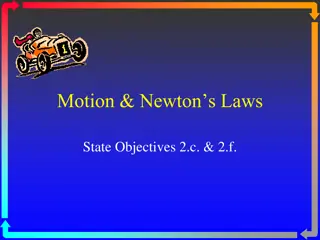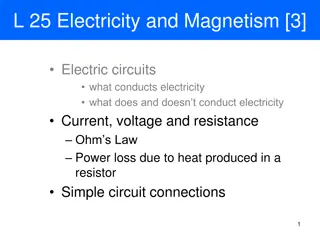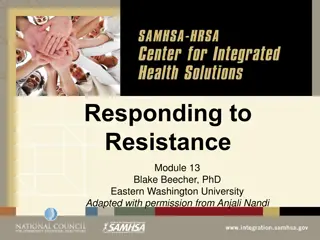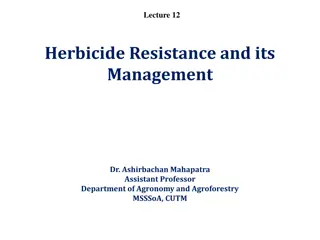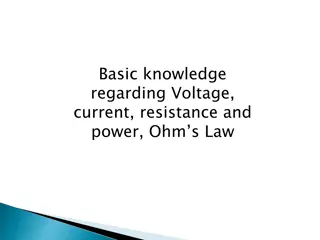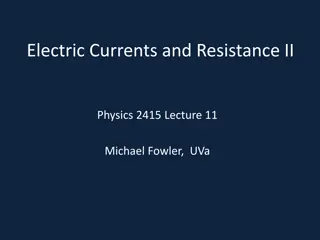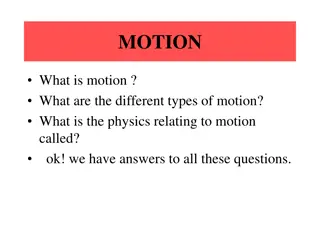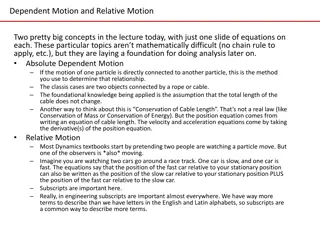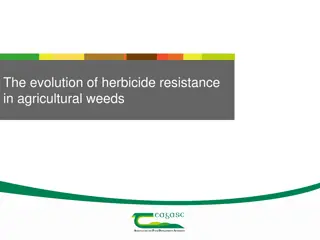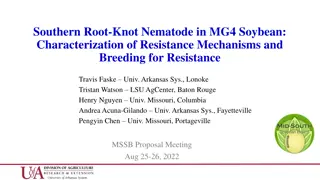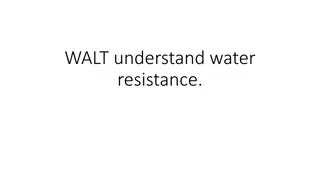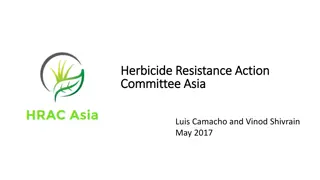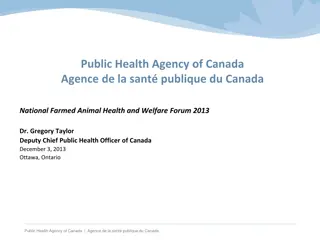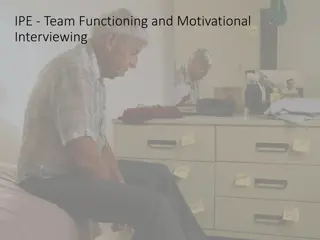Understanding Current, Resistance, and Charge Motion
Explore the fundamentals of current flow, resistance, and charge motion in this chapter. Learn about the factors influencing current, the behavior of free electrons in metals, and the impact of potential difference on charge motion. Discover Kirchhoff's laws and how current density is calculated.
Download Presentation

Please find below an Image/Link to download the presentation.
The content on the website is provided AS IS for your information and personal use only. It may not be sold, licensed, or shared on other websites without obtaining consent from the author. Download presentation by click this link. If you encounter any issues during the download, it is possible that the publisher has removed the file from their server.
E N D
Presentation Transcript
Chapter 26 Current and Resistance Charge in motion
Two major facts to be used in this chapter -e -e -e -e -e -e -e A -e -e -e -e -e -e -e Battery is the source of V Metal has free electrons That V can drive charge They can easily move
Current: Rate of flow of positive charge dq + + i = + + + + + dt + + + + + + + Unit of current = C/s = Ampere (A) + + + + + + + + + + The average current passes through a wire: ? =? ? q = it Why positive Charge? Because of the historical reason
Every metal has loosely bound electrons called free electrons. -e -e The speed of these free electrons is 6x106 m/s -e These electrons collides with atoms and always have a random motion Hence, there is no net current in a conductor
- + Net charge motion can be created by applying potential difference. -e -e -e If the negative charges moves from left to right the positive charges will move right from right to left - + +e The current is rate of flow of positive charge. +e +e arg ch e = curret time
At a junction: 1i Total current inflow = total current outflow i i = + i 2 1 3 3i = 0 i i i 2i 2 3 1 i = 0 Or The sum of the current at a junction is always zero Current flow is similar to liquid flow! This law is also called Kirchhoff s First Law
Until we apply the potential difference Total Charge (q) = Ne l N N -e -e = = n volume Al -e -e -e -e -e A -e -e = ( ) q n Al e -e -e -e -e -e q nAle = = = i nAev d t t t = time taken by charge to cross the length l l vd= t Current is generated by the component of vd parallel to A ? = ????.?
+ A vd + + i Current density (J) : How much current flow through per unit area of cross-section ? = ????.? ? = ????= ??????? ??????? ? = ?.? The current is due to the parallel component of the drift velocity. ? = ????? ? ? = ??
? = ?? + + + + + + + + + + + + + + ? =? + + + + ? + + + + + + Higher density T83-Q20. Electric charges flow through a wire shaped as shown in Fig. 5. The cross-sectional areas are A1= 4 mm2and A2 = 1 mm2respectively. What is the drift speed of the electrons in the narrow section of the wire if their speed is 0.08 m/s in the wider region? A) 0.32 m/s
Final-T031: Q#1: A cylindrical wire of radius R = 2.0 mm has a uniform current density J = 2.0x105 A/m2. What is the current through the portion of the wire between radial distances R/3 and R/2? (see figure 1) (Ans: 0.35 A)
Sample problem 3: What is the drift speed of the conduction electrons in a copper wire with radius r = 900 m when it has a uniform current i = 17 mA? Assume each Cu atom contribute one conduction electron to the current and that the current density is uniform across the wire s cross-section. Density of Cu = 8.96 gm/cc, atomic mass of Cu = 63.54. (Ans: 4.9x10-7 m/s)
Sample problem 1: Water flows through a garden hose at a volume flow rate dV/dt of 450 cm2/s. What is the current of negative charge? (Ans: 2.4x107 A)
Sample problem 1: Water flows through a garden hose at a volume flow rate dV/dt of 450 cm2/s. What is the current of negative charge? (Ans: 2.4x107 A) T41-Q#2: Three wires are joined together at a junction. A 0.40-A current flows toward the junction from one wire and a 0.3-A current flows away from the junction in the second wire. The current in third wire is (Ans: 0.10-A, away from the junction.) Sample problem 2: Current density in a cylindrical wire of radius R = 2 mm is uniform across a cross section of the wire and is J = 2x105 A/m2. What is the current through the outer portion of the wire between radial distance R/2 and R? (Ans: 1.9A) Final-T031: Q#1: A cylindrical wire of radius R = 2.0 mm has a uniform current density J = 2.0x105 A/m2. What is the current through the portion of the wire between radial distances R/3 and R/2? (see figure 1) (Ans: 0.35 A) T072: Q18. Two wires, as shown in the figure 1 below, are made of same material. If the current density through segment S1 is J1= 6400 A/m2 and the current density through segment S2 is J2= 1239 A/m2, then the diameter D2 of segment S2 is: A) 5.0 cm)
T62-Q19.: The potential difference across the ends of a wire is doubled in magnitude. If Ohm s law is obeyed, which one of the following statements concerning the resistance of the wire is true? (The resistance is not changed) T31-Q#3: A current of 5.0 A exists in a 10 ohms resistor for 5.0 min. How many electrons pass through any cross section of the resistor in this time? (Ans: 9.4*10**21)
Current always flow opposite to the electron flow V V = i i Ri -e -e -e -e -e -e -e A -e -e This is Ohm s Law -e -e -e -e -e 0 V R = Resistance of the material: It measures the difficultness to flow the current V R = R i i Unit of R =Volt/Ampere= Ohm ( ) Symbol of R V
Ohms Law i V = iR -e -e -e -e -e -e -e A -e -e Ohm s law is valid if the resistance is irrespective to the magnitude and polarity of the applied potential difference -e -e -e -e -e 0 V R Ohm s law is valid if the resistance is irrespective to the magnitude and direction of the applied electric field i V
R i The resistor which doesn t follow ohms law is called Ohmic resistor The resistor which follows ohms law is called Ohmic resistor V Ohmic material (eg: metals) Non-Ohmic material eg: semiconductor
i Longer the wire more the resistance -e -e R l -e -e -e -e -e A More the area more the current and less the resistance -e -e -e 1 -e -e R -e -e A 0 V l = R A = resistivity of the wire A A A = A V = = R iR = R il l il l E 1 V Unit of = .m = = J ( ) l i E A = J = E J
i 1 = -e -e -e -e -e -e -e A -e -e -e -e Just opposite to the resistivity, conductivity measures the easiness to flow the current. -e -e -e 0 V A l = = R l RA R i = = E J J E Unit = .m Unit = 1/( .m) V
T062-Q18.: If a wire is stretched uniformly to n-times its original length, it's resistance changes by a factor of: (n2)
Resistivity increases with temperature i = + T ( ) T 0 0 0 T0 = Reference temperature in Kelvin (usually room temperature V 0 = resistivity at reference temperature = Temperature coefficient of resistivity
U = qV i U= qV -e -e -e -e -e -e t t -e A -e -e -e -e -e Energy -e -e Power 0 Time V P = iV V = iV iR i R = = = 2 iR . P i R i 2 V V = = = P iV V R R V
i V R Electric Energy from the battery is transferred at the rate of P = iV to heat up the resistor
T83-Q19. A carbon resistor has a resistance of 18 at a temperature of 20C. What is its resistance at a temperature of 120 C? (The temperature coefficient of resistivity for carbon is - 5.0 10-4 /C .) A) 17
T83-Q18. Two cylindrical resistors R1 and R2 are made from the same material and have the same length. When connected across the same battery, R1 dissipates twice as much power as R2. The ratio of diameter of resistor R1 to that of R2 is: A) 2
T83-Q17. A 10-ohm resistor has a constant current. If 1200 C of charge flow through it in 4 minutes what is the value of the current? A) 5.0 A
T102-Q20. The filament of a light bulb is initially at 20.0 oC. It is connected to a voltage source which maintains a constant potential difference across the filament. The current in the bulb when it reaches its final operational temperature is one-tenth its value when the bulb is first turned on. What is the final operational temperature of the filament? Assume that the dimensions of the filament do not change, and that the temperature coefficient of resistivity of the filament is 0.00450 (oC)-1. A) 2020 oC T102-Q19. A light bulb has a 120 V potential difference applied to it. If the potential difference is increased to 150 V, what is the fractional increase in the power dissipated in the light bulb? Assume that the resistance of the light bulb remains constant. A) 0.56 T102-Q18. A 120 V potential difference is applied to the ends of a conducting wire, causing a current of 16 A to pass through it. If the length of the wire is 1.0 m, and the resistivity of its material is 1.0 10-6 .m, what is the radius of the wire? A) 0.21 mm
T91-Q20. A 10- resistor has a constant current passing through it. If 1200 C of charge pass through the resistor in 5.0 minutes, what is the magnitude of the potential difference applied to the resistor? A) 40 V T91-Q19. A copper wire has an initial resistance of 100 , and is connected to a 5.0 V battery. The temperature coefficient of resistivity of copper is = 4.3 10-3( C)-1 If the wire is cooled by 50 C : A) The power dissipated in the wire will increase by 68 mW. T91-Q18. An electric current of 0.35 A passes through a cylindrical copper wire of cross sectional area 3.1 10-6m2. What is the magnitude of the electric filed inside the wire? The resistivity of copper is 1.7 10-8 .m. A) 1.9 10-3V/m
T82-Q20. Two light bulbs operate from a 120-V voltage source. Bulb A has a power rating of 25.0 W and bulb B has a power rating of 100 W. Which of the following statements is CORRECT? A) Resistance of A is larger than resistance of B. T82--Q19. How much would the temperature of a copper wire have to be increased to raise its resistance by 20% over the value it had at 20oC? The temperature coefficient of resistivity of copper is 0.0040 (Co) 1. Neglect any change in length or cross sectional area due to the change in temperature. A) 50 Co T82-Q18. A certain resistor dissipates 0.500 W when connected to a 3.00 V potential difference. When connected to a 1.00 V potential difference, this resistor will dissipate: A) 0.0556 W
T81-Q20. A certain wire has resistance R. Another wire, of the same material, has half the length and half the diameter of the first wire. The resistance of the second wire is: A) 2R T81-Q19. A current of 0.300 A is passed through a lamp (light bulb) for 2.00 minutes using a 6.00 V power supply. The energy dissipated by this lamp during the 2.00 minutes is: A) 216 J
T51-Q#19. Two wires are made from different materials and carry the same uniform current. The current density in both is the same only if:((D) their radii are the same. T81-Q20. A certain wire has resistance R. Another wire, of the same material, has half the length and half the diameter of the first wire. The resistance of the second wire is: (Ans: 2R) T062-Q18.: If a wire is stretched uniformly to n-times its original length, it's resistance changes by a factor of: (n2) Q#20: What diameter must a copper wire have if its resistance is to be the same as that of an equal length of an aluminum wire with 3.26 mm diameter? [Resistivity of aluminum = 2.75*10**(-8) Ohm.m; Resistivity of copper = 1.69*10**(-8) Ohm.m; (A1 2.6 mm.)
T072: Q#20. A heater of unknown resistance is plugged into a 120-V line. The charge passing through it in one hour is 4800 C. What is the resistance of the heater? (Ans: 90 ) T81- Q19. A current of 0.300 A is passed through a lamp (light bulb) for 2.00 minutes using a 6.00 V power supply. The energy dissipated by this lamp during the 2.00 minutes is: (Ans: 216 J) T072: Q20. A 10 V battery is applied across a 15 W device. How much charge goes through the device in 4.0 hours? (Ans: 2.2 104 C) T062: Q20.: A 40-W and a 60-W light bulbs are designed for use with the same voltage. What is the ratio of the resistance of the 60-W bulb to the resistance of the 40-W bulb? (Ans: 0.67 ) Final-T032: Q#1 A 20% increase in the resistance of a copper wire was noticed when its temperature was raised above room temperature. Find the final temperature of the wire if the temperature coefficient of resistively for copper is 4.0*10** (-3) /K. [Assume the room temperature = 290 K] (Ans: 340 K.)
R Insulating sphere Long insulating cylinder R Long insulating sheet Long metal sheet R R R If each of the above shapes possesses Q charge a. What is the electric field at distance R/2 from the center of the sphere b. What is the electric field at distance R/
y R Insulating sphere Long insulating cylinder R Long insulating sheet x Long metal sheet R 1. If each of the above have shapes possesses charge Q = 10 C and R = 2.0 m. Each side of the sheets have area same as the surface area of the sphere. What is the electric field at distance R/2 from the center of the sphere? 2. What is the electric field at distance R/2 to the left from the center of the cylinder of length 10 m. For this problem take all information in question 1 but take the charge on metal sheet as -10 C.
y B A x (0,0) Figure (2) Two metallic spheres A ( R = 10 cm) and B (R = 5 cm) are located with their centers at (2.0m, 0) and (0, 3.0 m) respectively as shown in Fig. 2. 3. If ball B is neutral and A has Q = 10 C charge, how much charge need to be transferred to B so that the magnitude of electrostatic force between them is zero. 4. If neutral ball B is connected to ball A of charge Q = 10 C by a thin wire and get disconnected. Find the final charge on sphere B. 5. Adding to question 4 find the work required to move the sphere A to (4.0 m, 0) and sphere B to (0, 6.0). 6. If neutral ball B is connected to ball A of charge Q = 10 C by a thin wire and get disconnected. Find the charge at co-ordinate (2.0, 3.0) so that the net E at origin is zero.
7. A dipole of dipole moment 10 nC.m is perpendicular to an electric field of 100 N/C. If you apply 50 N.m torque to rotate it against the electric field how much work did you do? 8. The varibale electric field through the cube in figure (3) is E = 3xi + 4y j. Find the charge store inside the cube. y x (1.0,0) (0,0) Figure (3)



